|
During 2007-08, Your Croydon featured photographic essays from Frazer Ashford (JRGS 1962-69) as part
of his continuing series entitled From Here to Modernity, which
charted Croydon during the past 25 years.
In each column, Frazer considered the dramatic changes that have
taken place to local Croydon landmarks, but also the similarities
between the town in the Seventies and Eighties and the same locations
today.
Listed here his
various contributions to this interesting publication produced by Croydon
Council.
More
November
2007 | December 2007 |
February 2008 | March
2008 | April 2008 |
May 2008 | June 2008 |
July 2008 | August 2008 |
September 2008 |
October 2008 | November 2008
|
 |
 |
|
November 2007 | Issue 12 |
In his inaugural
November 2007
feature, Frazer compares photos taken of the Croydon Flyover.
Click each thumbnail below to view a larger version of
Frazer's From Here to Modernity images, or
here to view the 24-page magazine in PDF format.
As the article states: "Back around 1980, I was approached to
provide images for a publication entitled Croydon – The
Official Guide, an annual look at Croydon, setting out the
benefits of living and working within the borough. I went on to
provide the pictures for several years, and recently came across
the original 1981/82 edition.
“Looking through the numerous pictures, I became aware that some
places had changed dramatically, such as the Whitgift Centre,
while others, Woodcote Village Green for example, hadn’t changed
at all. However, I felt that the vast majority of places were
basically the same, with some minor alterations to the buildings
being the only evidence that 25 years had passed.
"To test my theory, I decided to retrace my steps and revisit many
of the locations I photographed then, to recreate those images,
in their modern settings, by standing on the same spot and using
the same lenses. My theory, however, took something of a blow.
“When I compared the images, I got quite a shock. While fully
expecting the extensive rebuilding work and the inevitable
progression of the modern office block to provide the biggest
changes to the landscape, it proved not to be the case.
“The biggest change was that Croydon has become greener. I’m not
referring to the great ‘carbon footprint’ debate, but greener in
the most literal sense. Croydon has more trees, especially in
the centre of town. Many of the original buildings are now
hidden from view by ever-expanding foliage.
“This would have been the last thing I’d have thought about if I’d
been asked about the changes in Croydon over the past 20 or so
years. Some locations have changed forever – flattened buildings
are not often reborn – but I believe it’s the trees that have
had the biggest visual impact. Now, who would have guessed
that?”
Below are an image of the western end of Croydon Flyover then, and
as it looks today.
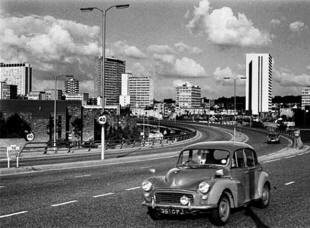
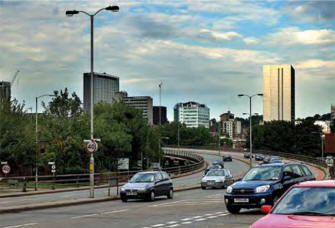 |
|
 |
 |
|
December 2008 | Issue 13 |
In his December 2007 feature,
Frazer compares photos taken in North End at the
junction with George Street on a busy shopping afternoon
with people dodging through the traffic, and the same scene as a
pedestrian-only zone. Click each thumbnail below to view
a larger version of Frazer's From Here to Modernity
images, or
here to view the 24-page magazine in PDF format.
As the article states: "North End was always the main artery
running through the centre of Croydon. It was a bustling mass of
people and traffic, particularly on Saturdays and during the
days leading up to Christmas, when it seemed to take forever to
travel from one end to the other. Then, in a stroke, the traffic
was gone and pedestrians ruled the world. It was different, but
something was missing – the heart had been taken out of our town
– the atmosphere had left with the last bus.
"But then something happened, a new atmosphere was born. Street
market stalls, kids’ roundabouts, exhibition stands, small café
areas and, most importantly, trees came to take the place of the
traffic. It might still be as busy as far as pedestrians are
concerned, but now you can see just how just much our main
artery has effectively been unblocked."
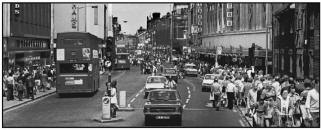 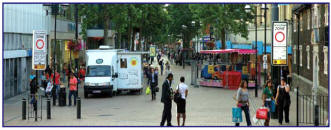 |
|
 |
 |
|
February 2008 | Issue 14 |
In his February 2008 feature,
Frazer compares photos taken in the High Street opposite
Grant's department store, before and after the traffic flow
was reduced. Click each thumbnail below to view a larger
version of Frazer's From Here to Modernity images, or
here to view the 32-page magazine in PDF format.
As the article states: "Grant Bros. was a large, if rather
old-fashioned, department store with an amazing frontage
overlooking High Street. I remember it being full of wood
flooring and wood panelling, unlike the modern stores of today.
High Street was a bustling place with a constant traffic flow as
it formed part of the main A23 that passed straight through the
centre of Croydon.
"Over the years, cars and trucks were rerouted, with only buses and
local traffic passing the buildings. Grants itself closed and,
after years of decay, a new complex including bars, a
multi-screen cinema and a health club opened on the site,
bringing a new lease of life to this part of our town.
Thankfully, most of the original Grant Bros frontage has been
retained and continues to give the area a unique look.
"I first photographed High Street in 1981 and when I returned, a
few months ago, I found it difficult to repeat my original shot
due to the trees that now seem to have taken over, giving the
area a very pleasant and green feel. In fact, the area is full
of pedestrian-friendly open-air seating, ideal for passing the
time of day or grabbing a bite of lunch.
"Interestingly, on studying the picture that I took back in 1981, I
see that the Grants frontage was covered in bunting. Does
anybody remember what was being celebrated?"
ML
adds: "Several Your Croydon readers wrote in
suggesting that the bunting was possibly in celebration of the
1981 marriage of Prince Charles to Lady Diana Spencer."
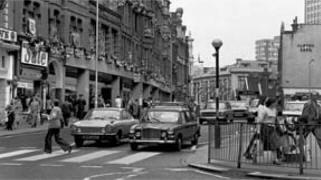
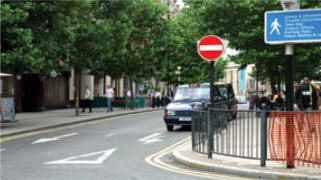 |
|
 |
 |
|
March 2008 | Issue 15 |
In his March 2008 feature, Frazer
revisits the Whitgift Centre. Click each thumbnail
below to view a larger version of Frazer's From Here to
Modernity
images, or
here to view the 24-page magazine in PDF format.
As the article states: "It was the heart of Croydon
and had been built
on the 12-acre site left vacant by Trinity School of John
Whitgift when it moved to Shirley in 1965. Boasting 200 shop
units and a large public house (The Forum) in a two-level
pedestrian precinct connected by escalators, a moving pavement
and circular ramps, all serviced by underground roads, it was
hailed as one of the most modern shopping centers in the UK. It
was the height of shopping luxury, but, never standing still,
has grown and developed over the years.
"Today, it has changed beyond all recognition from its original
layout. The main changes have included the division of the large
open areas into covered shopping avenues, offering many more
shops and restaurants, all under one roof.
"This month’s modern picture was taken from the same spot as the
black and white image, or as near as I could get, and really
shows just how much has changed. The Forum and the walking
pavement have gone, and, protected from the weather, it all
looks so much more inviting and friendly these days.
"To many, the Whitgift Shopping Centre – as it is now known – still
represents the heart of Croydon and, thanks to the major surgery
it has undergone over recent years, is likely to continue to do
so."
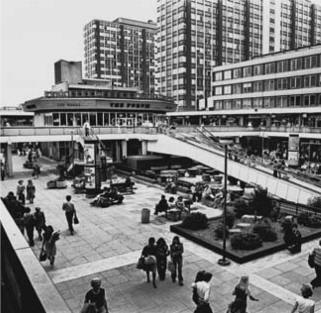
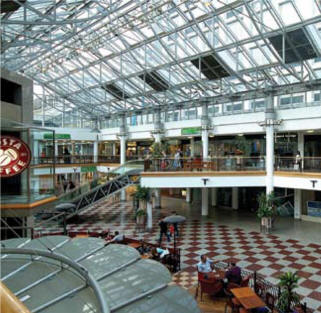 |
|
 |
 |
|
April 2008 | Issue 16 |
In his April 2008 feature, Frazer
compares photos taken in Wellesley Road looking south,
with the Whitgift centre shown on the right. Click each
thumbnail
below to view a larger version of Frazer's From Here to
Modernity
images, or
here to view the 24-page magazine in PDF format.
As the article states: "In living memory, the main
road running through Croydon has been the A23. For a time,
before Purley Way took that road designation, the A23 ran
through central Croydon, taking in North End, the very centre of
Corydon's shopping area.
"Parallel to this ran Wellesley Road which, until
1965, was a relatively quiet road bounded on its western side by
the Whitgift Middle School – better known as Trinity – and its
playing fields. The school moved and made way for the mighty
Whitgift Shopping Centre, which opened its first shop in 1968.
"As the volume in traffic through Croydon
increased, the relatively narrow North End became a bottleneck,
and Wellesley Road become the main thoroughfare for traffic
through the town centre. Surprisingly, the road has not changed
a great deal over the past 25 years. A couple of new buildings
have sprung up but perhaps the greatest change is to the road
furniture and markings that now
seem to dominate the scene.
"Trams also run down the centre of the road,
increasing the feeling that Wellesley Road carves a great swathe
through our town and divides the centre into two."
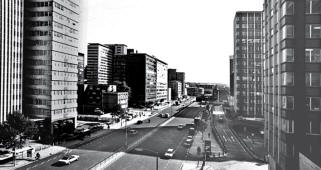
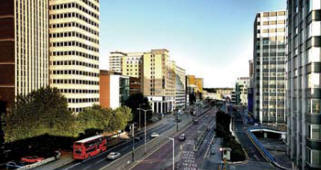 |
|
 |
 |
|
May 2008 | Issue 17 |
For his May 2008 feature, Frazer
compares photos taken of the Whitgift Almshouses, before
and after the tram lines were added along George Street and down
Crown Hill. Click each thumbnail below to view a larger
version of Frazer's From Here to Modernity images, or
here to view the 24-page magazine in PDF format.
As the article states: "In living memory, the main
road running through Croydon has been the A23. For a time,
before Purley Way took that road designation, the A23 ran
through central Croydon, taking in North End, the very centre of
Croydon's shopping area.
"At the corner of George Street and North End,
arguably the very centre of Croydon, are some very special
buildings. The Whitgift Almshouses, or to give them their real
name, The Hospital of the Holy Trinity, have occupied that
corner in Croydon since they were completed in 1599.
"The Almshouses have not only withstood the ravages
of time, but also the attentions of the planners who have
plotted their downfall many times in the interests of
reconstruction and road widening. The House of Lords finally
saved them permanently in 1923. While the Almshouses have
remained virtually unchanged, the roads outside have seen many
changes.
"North End, once the main thoroughfare through our
town, is now pedestrianised, while George Street operates
one-way traffic. Opposite the buildings, Crown Hill, over the
years, has been one-way traffic, driving up the hill; one-way
traffic, driving down the hill; and then pedestrianised, with a
strange red-brick observation platform-cum-seating area blocking
the road - which proved just as popular with the town’s pigeons
as its citizens.
"Now, however, it is part of the route for Croydon
Tramlink, with the frequent trams rolling across the junction
before gliding down the hill. So, it is ironic that this busy
junction, steeped in history, at the very heart of Croydon has
become the meeting point for one of our town’s oldest buildings
and a very modern urban travel innovation."
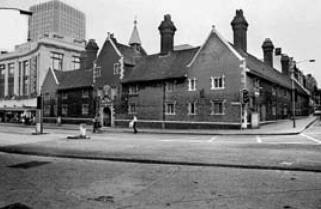
 |
|
 |
 |
|
June 2008 | Issue 18 |
In his June 2008 feature, Frazer
compares photos taken at East Croydon Station. Click on
each thumbnail below to view a larger version of Frazer's
From Here to Modernity images, or
here to view the 24-page magazine in PDF format.
As the article states: "Most of the archive
pictures in this series have been selected from the images that
I took for The Croydon Guide between 1978 and 1982. However,
while digging into my dusty old archives I found an unmarked
film that, by a process of elimination, appears to have been
shot in about 1965. I had saved my money and bought my first
camera, a PlusFlex 35mm SLR, from somewhere in Holborn when I
was living as a schoolboy a short distance from East Croydon
station. I got up very early the next day, a misty Sunday
morning, and set off into Croydon to test out this piece of
technology.
"So, this is not only one of my first pictures,
it’s certainly from the first roll of film that I developed with
an Ilford Home Photo Lab kit in my bedroom. I have included this
image in the series not for its quality but for the strangely
eerie and simple view of East Croydon. One bus stop, one car and
not a soul in sight.
"Apart from the old Victorian station on the left,
the other interesting factor is that, through the mist, you can
see an old house that I believe was a solicitor’s office. It was
demolished not long after this photo was taken to make way for
the NLA Tower, or the Threepenny-bit Building as it became
known. How things have changed for this part of Croydon that is
now the hub of the town’s transport system"
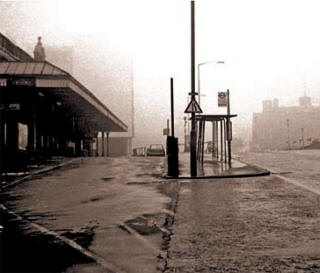
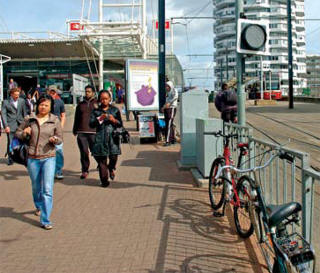 |
|
 |
 |
|
July 2008 | Issue 19 |
For his July 2008 feature, Frazer
compares photos taken of the former JRGS site on Tamworth
Road, West Croydon. Click on each thumbnail below to
view a larger version of Frazer's From Here to Modernity
images, or
here to view the 32-page magazine in PDF format.
As the article states: "This image is of Tamworth
Road looking north toward the London Road/North End junction.
Apart from the fact that the area was mainly residential then,
the outstanding point of interest is on the left-hand side of
the view, Croydon House.
"Some 13 years earlier, on 2 November, 1952,
Christopher Craig and Derek Bentley tried to break into this
building, the warehouse of confectionery manufacturer and
wholesaler Barlow & Parker. The two youths were spotted climbing
over the gate and up a drainpipe to the roof by a nine-year-old
girl in a house across from the building, the wall of which can
still be seen on the right-hand edge of both pictures. She
alerted her parents and her father called the police from the
nearest telephone box. As a result of events which are disputed
to this day, PC Sidney Miles was shot dead. Albert Pierrepoint
hanged Derek Bentley for the crime on 28 January, 1953, at
Wandsworth Prison.
"There have been many debates, campaigns and
arguments over the judgment and the sentence, but
there is no dispute that Tamworth Road has earned its place in
criminal history."
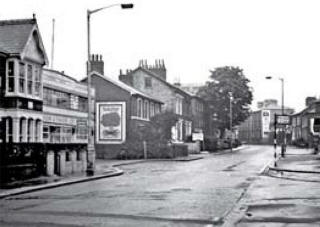
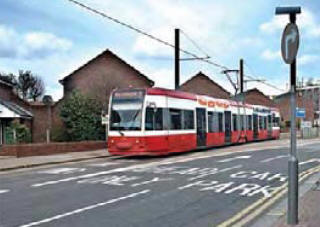 |
|
 |
 |
|
August 2008 | Issue 20 |
For his August 2008 feature,
Frazer remembers his childhood in New Addington. Click on
each thumbnail below to view a larger version of Frazer's
From Here to Modernity images, or
here to view the 24-page magazine in PDF format.
As the article states: "The first address that I
remember living at was a flat above Woolworths on Central
Parade. I guess that this must have been around the mid-’50s and
I would travel into Croydon to go to school on a daily basis.
Lodge Lane was just that, a country lane, and the land in front
of Central Parade, where the library and leisure centre now
stand, was just waste ground where I would ride my bike.
"At the far end of this ground, where Overbury
Crescent met Central Parade, not far from where the trams now
terminate, there was a large flat area that was a regular
location for many a fair or circus. I would lean out of my
bedroom window and watch the lights and hear the music on what,
to me, were wondrous occasions.
"The main change which occurred while we were
living there was the “joining up” of the two halves of Central
Parade. There were about 20 shops at the north end of the parade
and around the same number at the southern end. Slowly the gap
became smaller until, one day, the gap was gone and the long
parade that we know today was complete. I believe that the
original plans showed that a mirror image of the parade was to
be built opposite on the waste ground, but this never happened.
"We moved to South Croydon around 1959 and, apart
from returning to see old friends, I lost touch with the area.
"The picture shows the Parade in 1979 and, if you
can make out the Boots store, on the bend about five shops from
the right hand side of the picture, this was where, for many
years, the southern parade stopped – literally, the end of the
line, and we would look across a massive divide to the northern
parade in the distance."
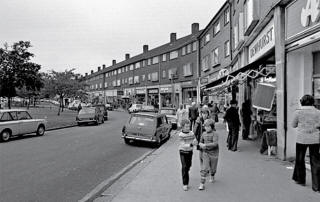
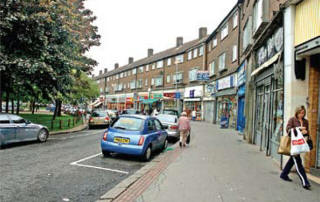 |
|
 |
 |
|
September 2008 | Issue 21 |
For his September 2008 feature,
Frazer raises a glass to a much-missed New Addington landmark.
Click on each thumbnail below to view a larger version of
Frazer's From Here to Modernity images, or
here to view the 24-page magazine in PDF format.
As the article states: "The Cunningham public house
was once the gateway to New Addington, especially before
Fieldway was developed. In the early days of New Addington,
Lodge Lane was but a narrow country lane and the first building
encountered on the journey up from Kent Gate Way was The
Cunningham, standing on the left at the junction of King Henry’s
Drive and Parkway.
"The large, traditionally-designed pub stood guard over those
entering the newly-built New Addington, but times and trade
patterns changed, and the public house became too big for its
own good.
"As with many similar buildings, it slowly fell
into disrepair, while still maintaining a bar service, but
eventually the pub closed its doors for the last time. Since
then, the building has been demolished and the land lies empty.
Whatever is eventually built, the new owners of the site must
acknowledge its unique gateway position.
"While it is commonly accepted that a new pub is
highly unlikely to be occupying the site, we should at least
raise a glass to the lost icon that was The Cunningham."
ML
adds: "It has been reported The Cunningham, which opened
in 1981 within the building formerly known as the Addington
Hotel, was pulled down for safety reasons after an alleged arson
attack. The German shopping firm Lidl then owned the land but
could not secure permission to build a supermarket on the site;
subsequently the firm opened a store on Parkway close to the
Central Parade. The Addington Hotel opened in the Thirties and
reportedly was used during the Second World War by pilots from
the nearby Biggin Hill airfield." [From
November 2014.]
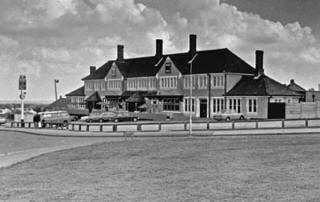
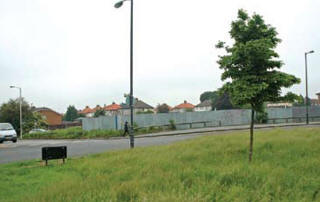 |
|
 |
 |
|
October 2008 | Issue 22 |
For his October 2008 feature,
Frazer spotlights Katharine Street. Click on each
thumbnail below to view a larger version of Frazer's
From Here to Modernity images, or
here to view the 24-page magazine in PDF format.
As the article states: "It’s 1977 and Katharine
Street is the centre of the borough’s colourful celebrations. It
was more than 30 years ago that Katharine Street was the site of
a spectacular parade organised to celebrate a notable
anniversary of national significance.
"So, it was around June, 1977, that my wife Clare, my six-month-old
daughter Beccy and I stood in the hot sun with the crowds to
celebrate the Queen’s
Silver Jubilee.
"The parade mainly comprised floats entered by local companies,
with Croydon Chamber of Commerce and Industry sponsoring one of
the biggest. Other attractions included military bands, the
Salvation Army, and a number of guests, including The Kent
Carolettes, an American-style marching band from Maidstone.
"The Jubilee year had already been a very good one for me, having
photographed the opening of The Queen’s Silver Garden in Hyde
Park, and seeing some of my pictures on display at The Queen’s
Silver Jubilee Photography Exhibition in Piccadilly, organised
by the British Institute of Professional Photography.
"This was my first exhibition and a memento is the programme to the
event, which I have to this day, tucked away in a drawer.
"Katharine Street seems much quieter these days, with buses being
the main form of road vehicle passing the Town Hall and Clock
tower complex. And with not a Kent Carolette in sight."
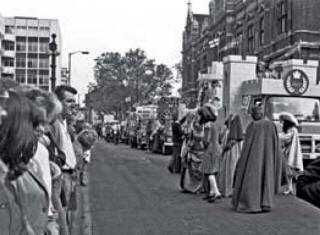
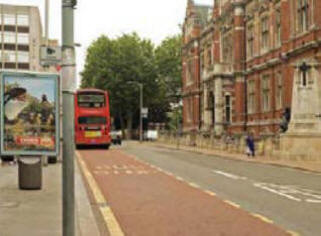 |
|
 |
 |
|
November 2008 | Issue 23 |
For his November 2008 feature,
Frazer turns his lens to the town center's principal shopping
street, North End.
Click on each thumbnail below to view a larger version
of Frazer's From Here to Modernity images, or
here to view the
24-page magazine in PDF format.
As the article states: "North End runs right through the heart
of the shopping centre of our town. This shot was taken looking
south from West Croydon, toward High Street and South Croydon,
on what was obviously a very quiet day! I guess that it may well
have been early on a Sunday morning, although with modern
shopping habits, North End is rarely seen as quiet as this
nowadays.
"Back then, cars were still allowed to drive along the road –
although even they seem to have disappeared for this picture.
"Looking at the shops, I notice that C&A is still on the eastern
(left) side of the street, next to Marks & Spencer. In time, the
shop outgrew this site and moved to a position on the opposite
side of the road, before finally closing down altogether, the
site being swallowed as part of the Centrale development.
"And – a point I’ve raised while assessing other pictures in this
series – look how much more greenery there is in the road now.
"Another point of interest is the domed building in the centre of
the image. This was an early cinema that had closed down years
before. Interestingly, the dome survives to this day and has
remained a distinctive part of the Croydon skyline.
"Although it cannot be seen in my picture, opposite that building
was another cinema, the Odeon, which
I would often visit. I had a school friend who lived in a flat
above it and I thought that it was the coolest place to live –
above a cinema!
"That cinema, too, was demolished, and standing now on part of the
site is Chapel Walk, one of the entrances to the Whitgift
Shopping Centre, and the McDonald’s restaurant.
"Apart from that, although it is difficult to see in this picture,
most of the shops were still small, privately owned businesses,
long before the multiple chain stores moved in.
"North End has changed a lot since those days, and I don’t think
that I am referring only to the loss of traffic,
now routed via Wellesley Road."
|
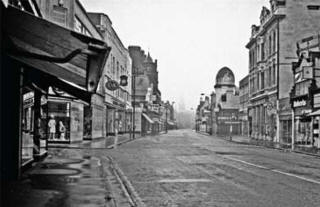 |
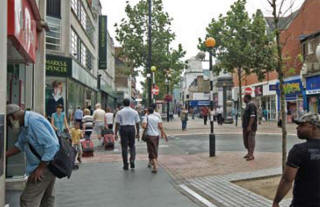 |
|
|















































